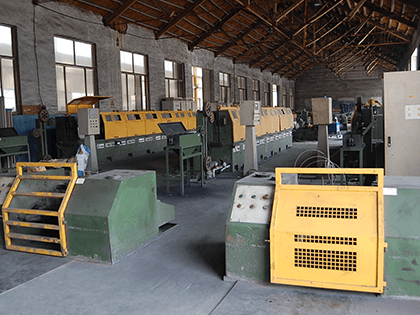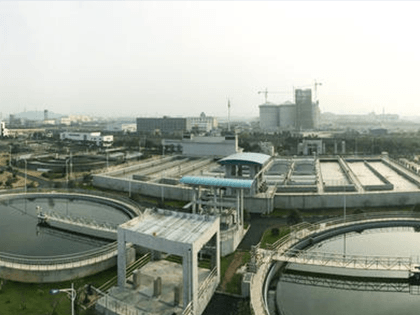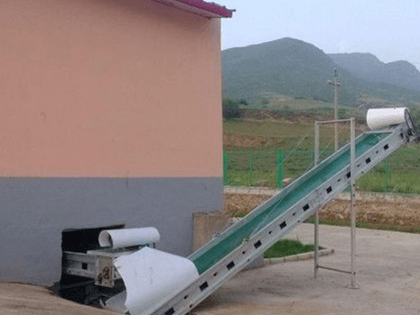Extract hydrogen from sludge promote full use of energy
Author: Taida machine Release time:2016-08-24
Reading guidance:Hydrogen is the most ideal clean energy. With rich resource and high combustion heat value, it will cause no pollution. It can be also applied to a wide scope. From the point of future use of energy, h
Hydrogen is the most ideal clean energy. With rich resource and high combustion heat value, it will cause no pollution. It can be also applied to a wide scope. From the point of future use of energy, hydrogen holds high energy value and zero emissions. In particular, it holds high efficiency and environmental protection value. It will become the future ideal energy forms. By using sludge to produce hydrogen, customer can not only solve the problem of environmental pollution of sludge and also can produce hydrogen gas to alleviate the energy crisis. This technology can produce hydrogen from sludge.
1. Bio hydrogen production from sewage sludge
Sludge bio hydrogen production by microbial enzyme catalyzed reaction at normal temperature and pressure can be prepared the principle of hydrogen. According to microbial growth needs the energy sources and sludge bio hydrogen has three methods: biological hydrogen production by photosynthetic and fermentative hydrogen producing bacteria, photosynthetic organisms and fermentation bacteria hydrogen production with mixed culture.
A. Photosynthetic hydrogen production
Aquatic microbial biomass hydrogen production by photosynthetic organisms is refers to in a certain light illumination, photosynthetic organisms (including bacteria and algae) decomposition of substrate to produce hydrogen. At present, the more hydrogen producing photosynthetic organisms mainly include: Oscillatoria spp, Rhodospirillum rubrum bacteria, Rhodobacter Pseudomonas bacteria, Rhodobacter micro bacteria. Using photosynthetic bacteria and algae synergy to fermentation hydrogen production can be simplified to heat treatment, reduce the cost and increase the hydrogen production. Another kind is capable of photosynthetic hydrogen production is blue-green algae, and higher plants contain photosynthetic system, but the cell characteristics is the original karyotype, belong to the original nuclear plants, containing hydrogen enzyme, can catalyze bio photolysis of hydrogen.
B. Use fermentation bacterium to produce hydrogen
photosynthetic bacteria and bacterial fermentation can also use a wide variety of substrates in Nitrogenase and hydrogenase substrate decomposition hydrogen production. These substrates including formate, lactate, pyruvate, various short chain fatty acid, glucose, starch, cellobiose and sulfide.
2. Disadvantage of using biological method to produce hydrogen
Biological hydrogen production technology level of the overall research is still in the basic stage, there is only limited to laboratory studies, experimental data for short-term test results, continuous and stable operation for a period of more than 40 case studies rarely. Even instant hydrogen production rate is high, long-term operation can obtain high yield remains to be discussed. In addition, natural anaerobic microorganism strains source mostly limited to activated sludge; biological hydrogen production of hydrogen donor limited to simple carbohydrates; most studies are concentrated in the cells and enzyme immobilization technology, such as to explore Hydrogen Producing Strains Screening and buried the agent of choice.
3. Using high-temperature gasification to produce hydrogen
Sewage sludge with high temperature gasification is generally refers to the sludge through thermo-chemical conversion to high grade gas or synthesis gas, then the separation of hydrogen. Join the gasification re-activity of agent and steam gasification, gasification activity agent is generally air, oxygen enriched air or oxygen.
4. Use super critical sludge to produce hydrogen
Sludge super critical water gasification hydrogen production is in the water temperature and pressure were higher than the critical temperature (374.3 DEG C) and critical pressure 22.05mpa to super critical water as reaction medium and dissolved in the organic matter occurred strong chemical reaction to produce hydrogen.
A. Reaction mechanism
B. Under super critical condition, gasification reaction of organic wastes mainly consider whole reaction relevant C, H, O. Super critical water is used as the reaction medium to produce hydrogen with strong chemical reaction with dissolved organic matter.
(1 )C+H2O→CO+H2(△H=131.3J/mol)(1)
(2)CO+H2O→CO2+H2(△H=-41.2J/mol)(2)
C. Current situation of foreign research
In 2004, Japan University of Tokyo Yoshida design 3 type continuous super critical water gasification reactor. The reactor comprises a pyrolysis reactor, oxidation reactor and contact reactor. The test analyzed the chemical reaction of the reactor, the optimal reaction parameters. 25.7mpa at 399.85 C, stay time is 60s under the condition of carbon gasification efficiency is 96%, the gas is mainly hydrogen and carbon monoxide, wherein, the volume fraction of hydrogen is about 57%[26]. of Japan's MITSUBISHI cement company to 20g organic waste (sludge, waste plastics etc.) add 50ml water, then put it into the super critical water reactor, in 650 C, reaction 25MPa reaction conditions to generate hydrogen and carbon monoxide gas mainly, and the total volume of gas to produce hydrogen 60%. and then use the hydrogen separation tube will generate hydrogen and other gas separation and collection The purity of hydrogen was obtained from the set of 99.6%.
5. Comparison and selection of applying sludge to produce hydrogen
A. Technical comparison
Sludge bio hydrogen, sludge high temperature gasification and super critical water gasification hydrogen production belong to at home and abroad at present sludge energy research new method on extraction, although is not very mature, but the application prospect is bright.
Three kinds of technology compared with super critical water gasification technology has the advantage of environmental protection and good application prospect, has accumulated some experimental results. This technique is a new, efficient and renewable energy conversion and utilization technology of biomass gasification and high energy conversion efficiency, strong ability of organic processing physical harm, mild reaction conditions, high product grade level. Combined with the recycling of sewage sludge and renewable and water phase, which can realize energy conversion and utilization as well as the nature of the virtuous cycle of sludge catalytic gasification in super critical water, sludge gasification rate can reach 100%, the volume fraction of hydrogen in the gas products even more than 50%, and the reaction does not produce coke, charcoal and other products, will cause two pollution, with good prospects for development.
B. Industrial selection problem
Super critical water gas of hydrogen production technology is not mature enough, if used in industry but also the need to further improve. Mainly include: provide typical components in sludge gasification rate and product gas composition data, considering the influence factors and the optimum reaction conditions were obtained. The selection of economic operation, has a longer service life of the catalyst and the corresponding vector; focus on understanding the effect of super critical water unique properties and on the surface and activity of catalytic reaction; to carry on the discussion to the multi-phase catalytic gasification reaction mechanism and reaction path, based on obtained more accurate kinetic data.
6. Conclusion
The technology of hydrogen production from sludge at home and abroad is the frontier of energy utilization technology, but it is still in the initial stage of exploration, there is no practical engineering experience can be used for reference, to this end, need to be further discussed.
In addition, we must pay special attention to some foreign energy method although is worth using for reference, but not all of the process parameters are suitable for the situation of our country, in practice need to be carefully considered; domestic itself is also a need to strengthen the sludge treatment, disposal and resource technology. In addition, to establish macro "sludge energy management system, avoid sludge generated by the energy loss, cause resource waste.
Zhengzhou Taida Drying Equipment Co., Ltd, as a professional environmental service providers, can provide service for municipal, industrial and rivers of sludge treatment and disposal. it can also provides consulting, design, construction, equipment integration, operation and investment services. Taida has built long-term cooperation with relevant companies and famous universities, such as Nanjing University, Tianjin University, Nankai University, Southeast University and other famous universities. With strong technical strength, harmonious construction and natural ecological environment responsibility, this technology can create great value for customers.
1. Bio hydrogen production from sewage sludge
Sludge bio hydrogen production by microbial enzyme catalyzed reaction at normal temperature and pressure can be prepared the principle of hydrogen. According to microbial growth needs the energy sources and sludge bio hydrogen has three methods: biological hydrogen production by photosynthetic and fermentative hydrogen producing bacteria, photosynthetic organisms and fermentation bacteria hydrogen production with mixed culture.
A. Photosynthetic hydrogen production
Aquatic microbial biomass hydrogen production by photosynthetic organisms is refers to in a certain light illumination, photosynthetic organisms (including bacteria and algae) decomposition of substrate to produce hydrogen. At present, the more hydrogen producing photosynthetic organisms mainly include: Oscillatoria spp, Rhodospirillum rubrum bacteria, Rhodobacter Pseudomonas bacteria, Rhodobacter micro bacteria. Using photosynthetic bacteria and algae synergy to fermentation hydrogen production can be simplified to heat treatment, reduce the cost and increase the hydrogen production. Another kind is capable of photosynthetic hydrogen production is blue-green algae, and higher plants contain photosynthetic system, but the cell characteristics is the original karyotype, belong to the original nuclear plants, containing hydrogen enzyme, can catalyze bio photolysis of hydrogen.
B. Use fermentation bacterium to produce hydrogen
photosynthetic bacteria and bacterial fermentation can also use a wide variety of substrates in Nitrogenase and hydrogenase substrate decomposition hydrogen production. These substrates including formate, lactate, pyruvate, various short chain fatty acid, glucose, starch, cellobiose and sulfide.
2. Disadvantage of using biological method to produce hydrogen
Biological hydrogen production technology level of the overall research is still in the basic stage, there is only limited to laboratory studies, experimental data for short-term test results, continuous and stable operation for a period of more than 40 case studies rarely. Even instant hydrogen production rate is high, long-term operation can obtain high yield remains to be discussed. In addition, natural anaerobic microorganism strains source mostly limited to activated sludge; biological hydrogen production of hydrogen donor limited to simple carbohydrates; most studies are concentrated in the cells and enzyme immobilization technology, such as to explore Hydrogen Producing Strains Screening and buried the agent of choice.
3. Using high-temperature gasification to produce hydrogen
Sewage sludge with high temperature gasification is generally refers to the sludge through thermo-chemical conversion to high grade gas or synthesis gas, then the separation of hydrogen. Join the gasification re-activity of agent and steam gasification, gasification activity agent is generally air, oxygen enriched air or oxygen.
4. Use super critical sludge to produce hydrogen
Sludge super critical water gasification hydrogen production is in the water temperature and pressure were higher than the critical temperature (374.3 DEG C) and critical pressure 22.05mpa to super critical water as reaction medium and dissolved in the organic matter occurred strong chemical reaction to produce hydrogen.
A. Reaction mechanism
B. Under super critical condition, gasification reaction of organic wastes mainly consider whole reaction relevant C, H, O. Super critical water is used as the reaction medium to produce hydrogen with strong chemical reaction with dissolved organic matter.
(1 )C+H2O→CO+H2(△H=131.3J/mol)(1)
(2)CO+H2O→CO2+H2(△H=-41.2J/mol)(2)
C. Current situation of foreign research
In 2004, Japan University of Tokyo Yoshida design 3 type continuous super critical water gasification reactor. The reactor comprises a pyrolysis reactor, oxidation reactor and contact reactor. The test analyzed the chemical reaction of the reactor, the optimal reaction parameters. 25.7mpa at 399.85 C, stay time is 60s under the condition of carbon gasification efficiency is 96%, the gas is mainly hydrogen and carbon monoxide, wherein, the volume fraction of hydrogen is about 57%[26]. of Japan's MITSUBISHI cement company to 20g organic waste (sludge, waste plastics etc.) add 50ml water, then put it into the super critical water reactor, in 650 C, reaction 25MPa reaction conditions to generate hydrogen and carbon monoxide gas mainly, and the total volume of gas to produce hydrogen 60%. and then use the hydrogen separation tube will generate hydrogen and other gas separation and collection The purity of hydrogen was obtained from the set of 99.6%.
5. Comparison and selection of applying sludge to produce hydrogen
A. Technical comparison
Sludge bio hydrogen, sludge high temperature gasification and super critical water gasification hydrogen production belong to at home and abroad at present sludge energy research new method on extraction, although is not very mature, but the application prospect is bright.
Three kinds of technology compared with super critical water gasification technology has the advantage of environmental protection and good application prospect, has accumulated some experimental results. This technique is a new, efficient and renewable energy conversion and utilization technology of biomass gasification and high energy conversion efficiency, strong ability of organic processing physical harm, mild reaction conditions, high product grade level. Combined with the recycling of sewage sludge and renewable and water phase, which can realize energy conversion and utilization as well as the nature of the virtuous cycle of sludge catalytic gasification in super critical water, sludge gasification rate can reach 100%, the volume fraction of hydrogen in the gas products even more than 50%, and the reaction does not produce coke, charcoal and other products, will cause two pollution, with good prospects for development.
B. Industrial selection problem
Super critical water gas of hydrogen production technology is not mature enough, if used in industry but also the need to further improve. Mainly include: provide typical components in sludge gasification rate and product gas composition data, considering the influence factors and the optimum reaction conditions were obtained. The selection of economic operation, has a longer service life of the catalyst and the corresponding vector; focus on understanding the effect of super critical water unique properties and on the surface and activity of catalytic reaction; to carry on the discussion to the multi-phase catalytic gasification reaction mechanism and reaction path, based on obtained more accurate kinetic data.
6. Conclusion
The technology of hydrogen production from sludge at home and abroad is the frontier of energy utilization technology, but it is still in the initial stage of exploration, there is no practical engineering experience can be used for reference, to this end, need to be further discussed.
In addition, we must pay special attention to some foreign energy method although is worth using for reference, but not all of the process parameters are suitable for the situation of our country, in practice need to be carefully considered; domestic itself is also a need to strengthen the sludge treatment, disposal and resource technology. In addition, to establish macro "sludge energy management system, avoid sludge generated by the energy loss, cause resource waste.
Zhengzhou Taida Drying Equipment Co., Ltd, as a professional environmental service providers, can provide service for municipal, industrial and rivers of sludge treatment and disposal. it can also provides consulting, design, construction, equipment integration, operation and investment services. Taida has built long-term cooperation with relevant companies and famous universities, such as Nanjing University, Tianjin University, Nankai University, Southeast University and other famous universities. With strong technical strength, harmonious construction and natural ecological environment responsibility, this technology can create great value for customers.
:Sludge disposal is inclined to energy utilization :Situation analysis of solar energy natural dehydration disposal and treatment
Relevant news
- 2016-01-12OSC-II Model Sludge Dryer Deliv
- 2016-01-1215T/Day Aerobic Dynamic Ferment
- 2016-01-12Matters Should Be Paid Attentio
- 2016-01-12Methods exploration of chemical
- 2016-01-12Analysis of circulating fluid b
Industry trends
- 2016-01-12Comparison Between Different Sl
- 2016-01-12Adding Calcium and Stable Dispo
- 2016-01-12Sludge Treatment: Methods for S
- 2016-01-12Use Dyeing Sludge As Resource
- 2016-01-12Current situation of sludge dis
Hot spots
Hot-sale products

- Leather Industry Sludge Drying
Production Capacity:1-2200t/h

- Welding Plating Sludge Drying S
Production Capacity:1-2200t/h

- Municipal Sludge Drying Solutio
Production Capacity:1-2200t/h

- Manure Sludge Drying Solution
Production Capacity:1-2200t/h
 中文
中文 English
English Home
Home
